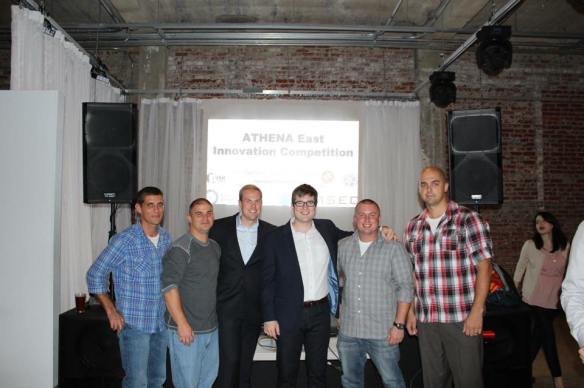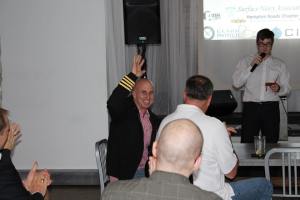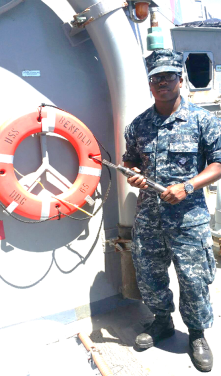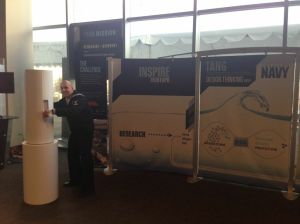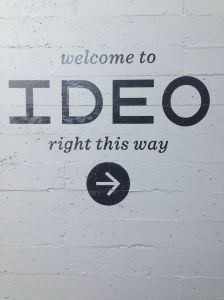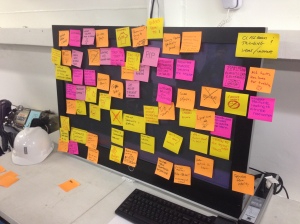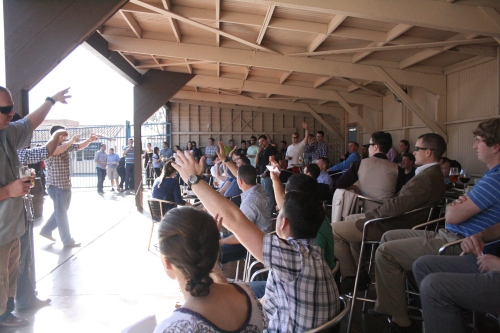By LT George Yacus
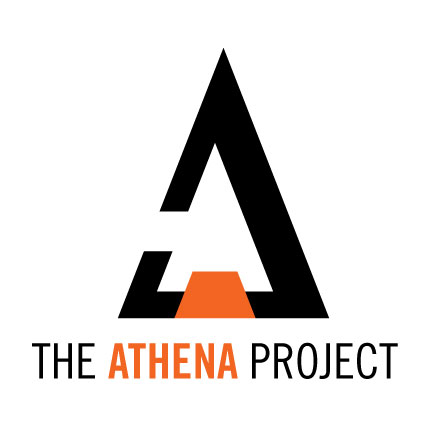
Hi everyone, Kilt here! Long time listener, but first time contributor here on The Athena Project.
Athena DC 1.0 — what a success on so many fronts–including the beautiful Potomac waterfront!
LOCATION, LOCATION, LOCATION!
Yes, I have to talk about location and timing!
Riding on the evening coattails of the local 2016 SEA AIR SPACE expo Monday night gave Athenians several great benefits for this inaugural session, including:
- An absolutely marvelous conference center snuggled in Maryland’s growing National Harbor on the beautiful Potomac (with access to adult beverages during the session if desired)
- A great showing of inquisitive participants from the Navy League’s Global Maritime Exposition, and
- Closer access to the refreshing Navy leadership who live on the fringes of our nation’s capital.
VADM Phil Cullom, Dr. Larry Schuette, Dr. Ralph Semmel, and Sharon Beermann-Curtin each took time out of their busy schedules–and maybe even missed a meeting or two–just so they could support our five Athena idea warriors as panelists. What a testament to their commitment in making innovation a priority for action and engagement!
INTRODUCTION
The session kicked off with Dave Nobles as our jovial Master of Ceremonies, sharing the history of Athena–which has held about 20 events so far and has become a beacon of success for Naval innovation. He also shared with us the concept behind Athena’s snazzy new logo.
Indeed, as Dave said, The Athena Project has become the “Bat Signal” for Naval innovation success.

Only in this case, there is no “super hero” coming to the Navy’s rescue here in our nation’s capital city, which is normally known for legislative sausage-making, 15 year defense acquisition cycles, and risk-averse policy decisions from whom VADM Cullom likes to call “The Borg”.

Acquisitions? Make it slow.
Instead, our heroes are diverse individuals just like you, who are not satisfied with assimilation into a sub par status quo! Instead, you are folks who exhibit our Navy’s core values with intellectual honor, courage, and commitment. You are willing to get an idea, run with it, and make it into a reality.
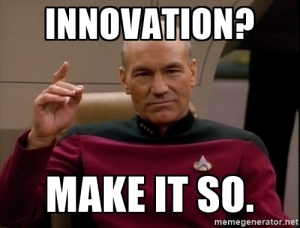
INSPIRATION!
After Dave got us going, our five presenters and audience gained encouragement from the ideation powerhouse that is FRCMA (Fleet Readiness Center Mid-Atlantic).
“Our command actually fosters innovation…from concept to culture.” said one of the guest speakers, ATC Williams from FRCMA, who was “blown away by communication between juniors and seniors” evident at his command, which has not one but two ideation think tanks that meet every other week, and also has systems in place where anyone can share their creative ideas.
Chief Williams and the FRCMA team shared nearly a dozen ideas and processes they’ve developed and implemented in the realm of Navy innovation, which he describes as “taking what’s out there, and using it in a new and exciting way.”
As a result, their work has spread from FRCs at Oceana and Norfolk to PAX River, New Orleans, and Washington.
But don’t let FRCMA’s success make you think that innovation comes easy, as we all know

FOD Prevention? Make it glow.
ideation success takes leadership, hard work, and commitment. Take for example LT Jason Shaw, who has spent ten years developing and then navigating funding and contract waters for his (literally) bright idea, which helps aviation maintenance personnel avoid FOD hazards (back to that theme in a second). Or consider AD2 Shepard’s ongoing work to develop a better cranial that fits comfortably, doesn’t save up sweat, and requires fewer parts.
Our Athena idea warriors thus gained inspiration from those who have gone before us, knowing that their–and your–ideas, can literally the save the Navy time, money, and more importantly, save the lives of our fellow warfighters.
So regardless of whether or not our idea presenters’ concepts are implemented now, or even a decade from now as they battle “The Borg” or as some of us like to say, the “Frozen

Innovation? Let it go.
Middle”, who just want to let good ideas go away, we’re thankful for all of our attendees’ presence, patience, and persistence, and we’re especially grateful to the Chains of Command that support ideators like them being able to attend!
DC 1.0 ATHENIANS
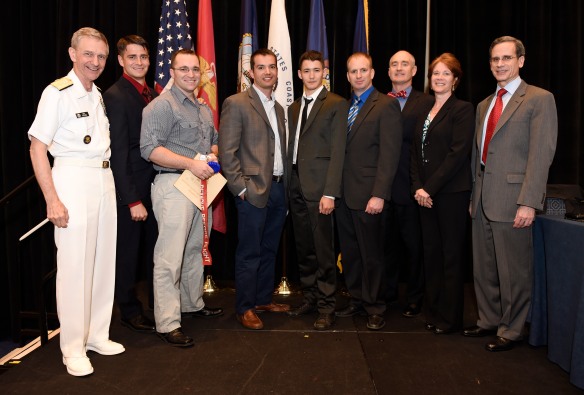
Our Athenians and our Panel from Athena DC 1.0! (U.S. Navy Photo by John F. Williams)
AT1 MICHAEL PECOTA OF FRCMA DET PAX RIVER: SONAR TRANSDUCER COVER
At the end of AT1 Michael Pecota’s presentation, I think our esteemed panelist ONR Research Director Dr. Larry Schuette put it best:
“Does anyone else think it’s crazy that we don’t already have it capped!?”
AT1 Pecota’s winning idea is a $10 3D printed solution to a $2,000,000 problem. And that problem is one near and dear to every aircrew and aviation maintenanceman’s heart: FOD…Foreign Object Damage. The MH-60R (our favorite sub-hunting organic maritime helo) carries a very complex $2M sonar transducer to detect and track lurking submarines. Unfortunately, when debris makes its way into the transducer, it takes our aviation electronics technicians and maintenance personnel a full hour just to take the cover off and clean house inside the transducer. By reducing FOD through prevention, AT1 Pecota’s sonar transducer cover can save the Navy upwards of 1708 man hours a year, equivalent to $76,000 back in the Pentagon’s budget. Sounds great! Unless you are an enemy submariner, am I right? His simple solution for a sonar transducer cap earned him the Admiral Sims Award for Intellectual Courage.

AT1 Pecota receives the Admiral Sims Award from VADM Cullom. (U.S. Navy Photo by John F. Williams)
[Note, if you are an MH-60R bubba, looking to get one of these caps for your transducer, reach out and we’ll connect you with AT1 Pecota. Let’s print these FOD-preventing bad-boys!]
LT JAMES LANDRETH OF NAVAL NUCLEAR POWER TRAINING UNIT, CHARLESTON SC: ADAPTIVE TESTING WITH MINERVA…THE ORACLE SUITE
Our second briefer carried the Athena torch with the mythology theme (woohoo!) LT James Landreth and his team pitched their innovative training/testing program “Minerva”, named after the Roman goddess of wisdom, art, Nuclear Power, school, etc.
Their team sees wide possibilities with the Navy Computerized Adaptive Test system, enabling them to predict with 85% accuracy a student’s success, generate customized or individualized training regimes, provide command leadership data-supported feedback on training systems, and help students avoid test failure. Nice!
LT DANIEL WALKER OF NAVAL SUPPLY SYSTEMS COMMAND: AUGMENTED REALITY BRIDGE
Collisions at sea. They happen. I wish they didn’t. LT Walker wants to make them stop happening. LT Dan wants every ship to keep their sea legs.
As a former CRIC-ster, he is the project lead for OCEAN AUGMENTED REALITY. The idea is to take all the great sensors and information we have available on a bridge: map data, radar contact information, depth charts, etc., and synthesize it and present it to our watchstanders through augmented reality glasses to reduce collisions. LT Walker’s project came in second place at Athena DC 1.0. What an exciting challenge!
LT TAKERU TAJIRI OF LCS CREW 104: E-SIGNALMAN
This is the idea that made it difficult for me to get to sleep last night!
It doesn’t take an engineer to realize that our electromagnetic spectrum is becoming more and more crowded and contested. Just ask LT Takeru Tajiri, a Poli-Sci major from the Juggernauts of LCS Crew 104 who wants to breathe new life into an old concept like Morse code by addressing how we communicate when all the radios are jammed, or when EMCON (emissions control) conditions have been established. The idea is to shift over to the shorter wavelengths on the EM spectrum, using visible light, infrared and/or laser, to send communication data from ship to ship or aircraft, and potentially relay data via unmanned vehicles/balloons to go over the horizon.
I really want to see all the tinkerers out there in the Navy come together and rally around this one, because I just KNOW that some sailors (including midshipmen) out there can design and build this one in a weekend or two! Who is with me? Let’s do it!
HM2 JOSHUA CRANFORD OF ANNAPOLIS NAVAL HOSPITAL: PROJECT WATER ENGINE
Our final presenter of the evening had me chuckling as he started with a great pun about sourcing energy and electrical current from water in the form of hydrogen.
HM2 Joshua Cranford is ready for the Navy to lead the way in green energy! Taking inspiration from the SECNAV’s Great Green Fleet initiative, HM2 wants to transition to H2… using hydrogen gas as a safer, climate friendly, and some day cost effective alternative fuel source to fossil fuels. Citing many recent trends, including successful projects from the University of West Virginia, HM2 Cranford encouraged us to take the long look for sustainability in how we power our Fleet. His presentation, while cut a little short due to timing, was still a gas!
CONCLUSION
Wow, what a night! In the end VADM Cullom tied it all together by spotlighting the strategic link between deckplate ideation, and Design for Maritime Superiority released by the Chief of Naval Operations. Specifically, he cited the line of effort regarding High Velocity Learning. He also explained that he wants to see Athena spread to every fleet concentration area.
“I have been in awe of what Athena has done…”
-VADM Phil Cullom (OPNAV N4)
We’re so thankful for our presenters for having the courage to share their ideas. How exciting it is that we can have sailors from all across the US come and meet together to make positive change in our Navy. Even though this was the first Athena event in DC, I’d say the “Bat Signal” is shining brightly here. Again, we must thank the leadership who have helped empower deckplate thinkers.
In conclusion, for some, it has been a 10 year journey to get here! And for others, it was just a few minutes of traffic around the DC Beltway. But regardless of whether you are an idea creator or an idea catalyst, newcomer or serial thinker, wherever you are in the realm of Naval innovation, remember, as VADM Cullom said this evening about The Athena Project…
“This is your forum!”
LT George Yacus is an MH-60S helo bubba, currently on shore duty to USNA at the Class of 1963 Center for Academic Excellence, where he provides communication and outreach for student academic support services, including training midshipmen in collaborative learning techniques, speed reading, time management, and more. In his free time he connects with other creative thinkers around the Yard and Fleet, and he is always looking to find ways to introduce innovation communities to midshipmen, faculty, and staff, and especially the aviation community at USNA.
There are Athena events coming soon to fleet concentration areas around the globe, so if you’re in Mayport, San Diego, Yokosuka and Norfolk – get ready! If you’re interested in starting a movement of your own, find us on Facebook or Twitter (@athenanavy) or e-mail us at athenanavy@gmail.com!

